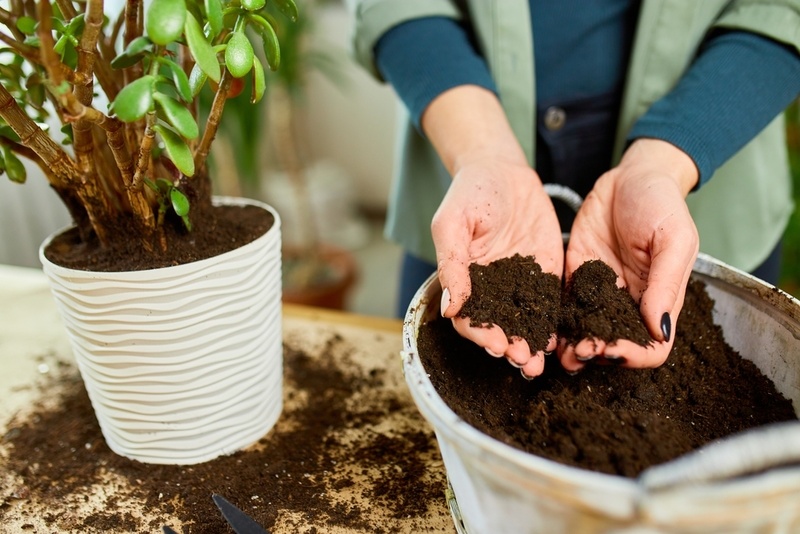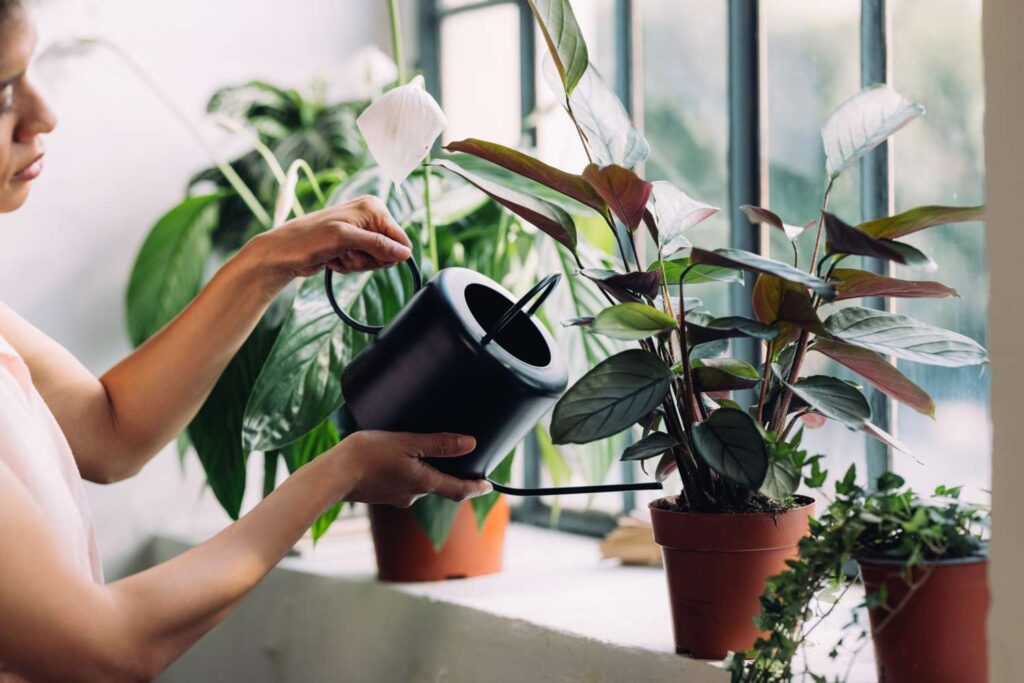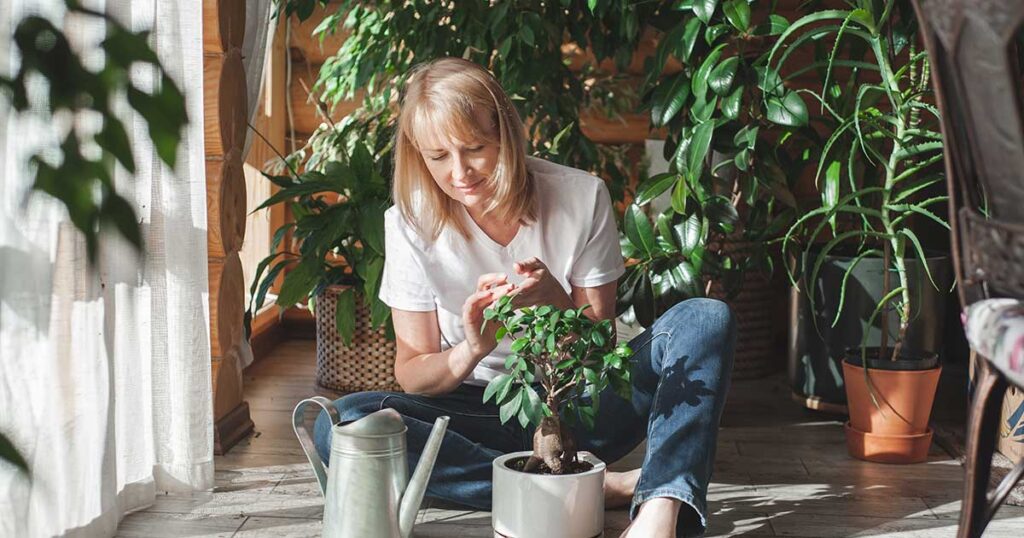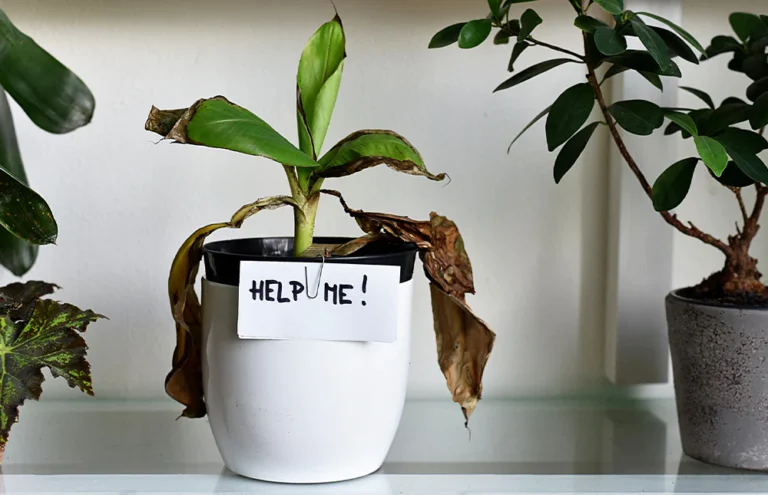Contents
Introduction
If you’ve ever looked at your indoor plants and wondered why they’re not thriving, you might be dealing with one of the most common plant care issues: overwatering. It might sound counterintuitive—after all, plants need water to live, right? But just like too much of a good thing can be bad, so can overwatering your green buddies.
When you overwater your plants, you’re basically drowning them. This doesn’t just mean the soil gets too soggy; it means the roots, which are responsible for absorbing nutrients and oxygen, get smothered and start to rot. As a result, your plants can show some pretty sad signs like wilting leaves, yellowing foliage, or even a funky smell coming from the soil.
But don’t worry! If you’ve noticed any of these red flags, you’re not alone, and there’s plenty you can do to get your plants back on track. In this guide, we’ll walk you through the common signs that your plants are getting too much water and share some easy fixes to help you turn things around. Plus, we’ll give you some tips on how to keep this from happening in the future, so you can keep your indoor garden happy and healthy.
So grab your favorite plant, and let’s dive into how to rescue it from too much water!
Identifying the Signs of Overwatering
If you’re worried that you might be giving your indoor plants too much water, it’s important to know what to look for. Plants are pretty good at sending us signals when something’s wrong, and overwatering often comes with a few telltale signs. Let’s break down these clues so you can catch any issues early and get your plants back to their best.
Wilting and Yellowing Leaves
At first glance, wilting might seem like a sign that your plant needs more water, but it can actually mean just the opposite. If your plant’s leaves are looking limp and droopy, even though you’ve been watering regularly, it could be a sign that the roots are too waterlogged. This happens because overwatered roots can’t absorb water properly, leading to that sad, wilted look.
Yellowing leaves are another classic symptom of overwatering. When the leaves start turning yellow, especially starting from the bottom of the plant and moving upward, it’s often a red flag. This discoloration happens because the roots are struggling to get the oxygen they need, which affects the plant’s overall health.
Root Rot and Foul Odor
Let’s get a bit less pleasant for a moment—root rot. If you notice that the roots of your plant are looking mushy, dark, or even slimy, it’s a sign that they’re rotting due to excess moisture. Root rot can be pretty smelly, too, often giving off a musty or rotten odor that’s hard to miss. This is a serious issue and needs to be addressed quickly to save your plant.
Mold and Fungus Growth
Another sign that your plant might be getting too much water is the appearance of mold or fungus. If you see white or gray mold on the soil’s surface, or even tiny mushrooms popping up around your plant, it’s a clear indicator that the soil is staying too wet. Mold thrives in damp conditions, so this is a sure sign that you need to change your watering habits.
Soil Condition
Take a closer look at the soil in your plant’s pot. If it feels constantly soggy, even after you’ve stopped watering, or if the soil is becoming compacted and dense, these are signs of overwatering. Healthy soil should have a bit of moisture but should not feel like a swamp. Compacted soil also means less air is reaching the roots, which can lead to further problems.

Dropping Leaves and Edema
Finally, keep an eye on how the leaves are behaving. If your plant is shedding leaves rapidly or you notice strange swellings and blistering on the leaves (a condition known as edema), it could be due to excess water pressure inside the plant. While this might look alarming, adjusting your watering routine can often help your plant recover.
By being on the lookout for these signs, you can catch overwatering issues early and take steps to fix them before they cause too much harm. Don’t worry if you spot a few of these problems—plants are resilient, and with a little care, you can help them bounce back!
Understanding the Causes of Overwatering
So, you’ve spotted the signs of overwatering in your indoor plants—now it’s time to figure out what’s causing it. Understanding the reasons behind overwatering will help you prevent it from happening in the future and keep your plants healthy and happy. Let’s dive into the common causes of overwatering and how you can address them.
Inadequate Drainage
One of the biggest culprits behind overwatering is poor drainage. If your pots don’t have drainage holes, excess water can get trapped at the bottom, leading to soggy soil and root rot. Even if your pot has drainage holes, the soil mix might not be up to snuff. Soil that’s too dense or heavy can retain too much moisture, which can also cause problems.

To fix this, make sure your pots have drainage holes and use a well-draining potting mix. Adding materials like perlite or sand to your soil can help improve its ability to drain water effectively, keeping your plant’s roots from sitting in water.
Incorrect Watering Schedule
Another common issue is watering your plants too often or too infrequently. It’s easy to think that plants need water on a strict schedule, but different plants have different needs. Some might need a lot of water, while others prefer to dry out between waterings. Overwatering can occur if you water your plants more frequently than they need or if you’re not adjusting for seasonal changes and different growth stages.
To get it right, check the soil moisture before watering. A simple finger test (sticking your finger about an inch into the soil) can tell you if the soil is dry or still moist. Adjust your watering schedule based on the plant’s needs and the time of year.
Humidity and Temperature Issues
High humidity levels and cool temperatures can also contribute to overwatering problems. When the air is too humid, the soil takes longer to dry out, which can lead to waterlogged conditions. Similarly, if the temperature is too low, the soil won’t dry out as quickly, and excess water can build up.
To manage humidity, try increasing air circulation around your plants with a fan or by opening windows. For temperature, make sure your plants are in a spot with consistent, moderate temperatures suitable for their species.
By addressing these causes, you can help prevent overwatering and keep your plants thriving. Remember, it’s all about finding the right balance for each plant and their specific environment. With a bit of attention and adjustment, you’ll have your indoor garden in top shape!
How to Fix Overwatered Plants
If you’ve discovered that your indoor plants are suffering from too much water, don’t panic! There are several effective ways to help your plants recover and get them back to their healthy selves. Let’s go through some simple steps you can take to fix overwatered plants and prevent future issues.
Adjusting Watering Practices
The first thing you need to do is adjust your watering habits. Overwatering often stems from watering your plants too frequently, so it’s essential to figure out the right amount of water they need.
- Check Soil Moisture: Before watering, check if the soil is still moist. You can use a moisture meter or just stick your finger about an inch into the soil. If it feels dry, it’s time to water; if it’s still moist, wait a bit longer.
- Establish a Watering Routine: Develop a watering schedule based on your plant’s needs and the season. Some plants need regular watering, while others prefer their soil to dry out between waterings. Adjust your routine accordingly to prevent overwatering.
Improving Drainage
Improving the drainage of your plant’s pot and soil can help prevent future overwatering problems.
- Repotting: If your plant is in a pot without drainage holes or if the soil is too compacted, it’s time to repot. Choose a pot with proper drainage holes and use a well-draining potting mix. This helps excess water escape and prevents water from pooling at the bottom.
- Soil Amendments: Mix in materials like perlite, sand, or bark to improve soil aeration and drainage. This allows water to flow through more easily and reduces the risk of waterlogging.
Managing Humidity and Temperature
Controlling the humidity and temperature around your plants can also make a big difference.
- Increase Air Circulation: Use fans or open windows to help reduce humidity levels around your plants. Better air circulation helps the soil dry out more quickly.
- Adjust Temperature: Keep your plants in a location with stable, moderate temperatures. Avoid placing them in drafty or excessively cool spots, as this can slow down the drying process.
Treating Root Rot and Mold
If your plant has already developed root rot or mold, take immediate action to address these issues.
- Pruning Affected Roots: Remove any rotten, mushy roots with clean scissors or pruners. Repot your plant in fresh, well-draining soil to give it a better chance of recovery.
- Treating Mold: For mold or fungus on the soil, reduce watering and consider applying a fungicide if necessary. Ensuring better drainage and air circulation will also help prevent mold from coming back.
Monitoring Plant Recovery
After you’ve made these adjustments, keep a close eye on your plant to see how it responds.

- Regular Checks: Look for signs of improvement, such as new, healthy growth and improved leaf color. If the plant still shows signs of stress, you might need to make further adjustments.
- Adjust Care as Needed: Continue to tweak your care routine based on how your plant is doing. Sometimes it takes a bit of trial and error to find the perfect balance.
By following these steps, you can help your overwatered plants recover and thrive once again. Remember, plants are resilient, and with the right care, they’ll bounce back in no time!
Preventing Overwatering in the Future
Now that you’ve helped your plants recover from overwatering, let’s focus on how to prevent it from happening again. Keeping your indoor plants happy and healthy is all about creating the right conditions and habits. Here’s how you can ensure your plants get just the right amount of water and stay in top shape.
Choosing the Right Pots and Soil
Selecting the right pots and soil is crucial for preventing overwatering issues.
- Pot Selection: Choose pots with drainage holes to allow excess water to escape. Pots without drainage can trap water at the bottom, leading to soggy soil and root rot. Make sure the size of the pot is appropriate for the plant; too large a pot can retain excess moisture, while too small can restrict root growth.
- Soil Quality: Use a potting mix that is well-draining and suitable for your specific plant. Different plants have different soil needs, so select a mix that matches your plant’s requirements. For example, succulents and cacti need a sandy, well-draining mix, while tropical plants prefer a mix with good water retention but still adequate drainage.
Establishing a Watering Schedule
A consistent watering schedule helps prevent overwatering and ensures your plants get the right amount of moisture.
- Plant-Specific Needs: Research the watering requirements for each type of plant you have. Some plants thrive on frequent watering, while others prefer to dry out completely between waterings. Knowing your plants’ preferences will help you water them correctly.
- Seasonal Adjustments: Adjust your watering routine based on the time of year. In cooler months or during periods of low light, plants generally need less water. During the growing season, usually spring and summer, plants may need more frequent watering.
Educating Yourself on Plant Care
Ongoing education is key to keeping your plants healthy and preventing overwatering issues.
- Continuous Learning: Stay updated on the best practices for plant care by reading books, visiting gardening websites, and joining plant care communities. Learning about plant-specific needs and general care tips will help you make informed decisions.
- Resources: Utilize available resources such as plant care apps, gardening blogs, and online forums to get advice and share experiences with fellow plant enthusiasts. These can provide valuable insights and solutions to common plant care challenges.
By incorporating these practices into your plant care routine, you’ll help prevent overwatering and keep your indoor garden flourishing. Remember, happy plants make for a happy home, and with a bit of knowledge and attention, you can create the perfect environment for your green friends.
Conclusion
Dealing with overwatered plants can be a bit daunting, but with the right knowledge and a few practical steps, you can turn things around and keep your indoor garden thriving. By recognizing the signs of overwatering, understanding its causes, and applying the right fixes, you’ll help your plants bounce back and flourish.
To recap, keep an eye out for common symptoms like wilting, yellowing leaves, and foul odors, as these can be clear indicators that your plants have had too much water. Make adjustments to your watering habits, improve drainage, and manage humidity and temperature to create the best conditions for your plants.
Preventing overwatering in the future involves choosing the right pots and soil, establishing a proper watering schedule, and continually educating yourself about plant care. By staying informed and making mindful adjustments, you can keep your plants healthy and happy.
Remember, every plant is unique, and finding the perfect balance for each one might take some trial and error. But with patience and a bit of care, you’ll soon have a vibrant, thriving indoor garden that brings you joy.
So, go ahead and apply these tips to your plant care routine. Your indoor garden will thank you with lush, healthy growth and beautiful foliage. Happy gardening!



